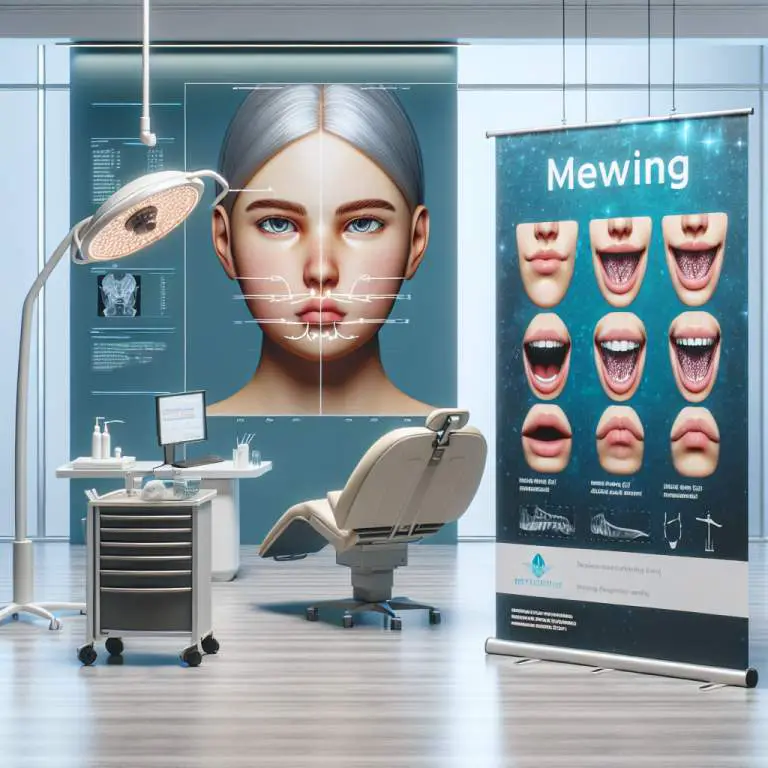What are the best practices for mewing to enhance the jawline?
To practice mewing correctly and enhance your jawline, start by resting your entire tongue on the roof of your mouth, not just the tip. Make sure your lips are together, but your teeth should be slightly apart without clenching. Keep your posture straight to help position your tongue properly. Doing this consistently every day is key to seeing improvements in your jawline.

How does mewing work to enhance the jawline?
Mewing is a technique that involves positioning your tongue against the roof of your mouth. This position is supposed to help shape and define your jawline over time. The idea is that by keeping your tongue in this specific spot, you’re applying gentle pressure which can potentially change the way your jaw looks.
When you practice mewing, it’s not just about where your tongue rests. It also encourages proper breathing through the nose and maintaining good posture. These elements together are believed to work on improving the appearance of your jawline by possibly influencing the alignment and structure of your facial bones.
What are the foundational steps to begin mewing correctly?
To start mewing correctly, first, you need to understand how to position your tongue properly. The tip of your tongue should be placed just behind your upper front teeth on the roof of your mouth. Then, spread the rest of your tongue across the roof as flatly as possible. This might feel strange at first but with practice, it becomes more natural.
Next, make sure you’re breathing through your nose while keeping your lips gently closed. Good posture is also key; keep your back straight and shoulders back. Combining these steps helps ensure that you’re practicing mewing in a way that could potentially benefit the structure and appearance of your jawline.
Can mewing be effective for all age groups, and are there different approaches based on age?
Mewing can be practiced by people of almost any age, but its effectiveness might vary depending on how old you are. Younger individuals, especially those still growing, may notice more significant changes because their bones are still developing. For them, mewing could influence bone growth in a way that enhances their jawline.
For adults, changes from mewing might be subtler since their bone structure is fully developed. However, adopting proper tongue posture and improving breathing patterns can still have benefits for facial appearance and health regardless of age. It’s important for each person to approach mewing with realistic expectations based on their unique situation.
What common mistakes should beginners avoid when starting mewing?
A common mistake many beginners make is applying too much pressure with their tongue against the roof of their mouth. Mewing should not cause discomfort or pain; it’s about maintaining gentle pressure consistently over time rather than forcing it.
Another mistake is forgetting about other aspects like nasal breathing and good posture which play crucial roles in making mewing effective. Focusing solely on tongue position without addressing these factors can limit potential improvements to one’s jawline from practicing mewing.
| Step | Description | Tips |
|---|---|---|
| 1. Correct Tongue Posture | Place the entire tongue on the roof of your mouth, including the back of the tongue. | Ensure your whole tongue is in contact with the palate, not just the tip. |
| 2. Lip Seal | Gently close your lips without forcing them. | Maintain a relaxed facial expression to avoid tension. |
| 3. Nasal Breathing | Breathe through your nose, keeping your mouth closed. | If you find nasal breathing difficult, consider consulting an ENT specialist. |
| 4. Chin Tuck Exercise | Perform chin tucks to strengthen neck muscles and improve posture. | This exercise can be done several times a day for short durations. |
| 5. Consistency & Patience | Mewing requires consistent practice over months or even years for noticeable results. | Be patient and make mewing a part of your daily routine for best outcomes. |
| Note: Mewing should be practiced with caution and it’s advisable to consult with a professional if you experience any discomfort or pain during the process. | ||
How long does it typically take to see results from mewing, and what factors influence this timeline?
Seeing results from mewing can vary greatly from person to person. Some people might notice changes in a few months, while others may need a year or more. The key is consistency and patience.
Several factors can influence how quickly you see results. These include your age, the current structure of your jawline, and how consistently you practice mewing. Younger individuals tend to see faster results due to their bones still being in the development phase.
Are there any scientific studies supporting the effectiveness of mewing for jawline enhancement?
Currently, there are limited scientific studies directly linking mewing to significant jawline enhancement. Most evidence supporting mewing comes from anecdotal reports and before-and-after photos shared by individuals online.
However, some related research on orthotropics (a broader field that includes mewing) suggests potential benefits for facial structure improvement. It’s important for more comprehensive studies to be conducted to fully understand the effectiveness of mewing.
What additional exercises or practices can complement mewing for better results?
Besides consistent mewing, incorporating certain exercises can help enhance your results. Jaw exercises, like chin-ups and jaw clenching, can strengthen the muscles around your jawline and contribute to a more defined look.
Practicing good posture is also crucial. A straight spine aligns your jaw properly and supports the changes you’re trying to make with mewing. Combining these practices with regular mewing can lead to better outcomes.
Final Thoughts
Mewing presents an intriguing approach to improving one’s jawline through non-surgical means. While individual results may vary and scientific backing is still emerging, many find value in its practice.
If you’re considering starting mewing, remember that patience and consistency are key. Complementing it with additional exercises and maintaining good posture can further enhance your chances of seeing positive changes.







